AD624 is Instrumentation amplifier of Analog Devices,
designed primarily for use with low level transducers,including
load cells, strain gauges, thermocouple and pressure transducers.
Picture shows the AD624 being used as a software programmable
gain amplifier. Gain switching can be accomplished with
mechanical switches such as DIP switches or reed relays. It
should be noted that the “on” resistance of the switch in series
with the internal gain resistor becomes part of the gain equation
and will have an effect on gain accuracy.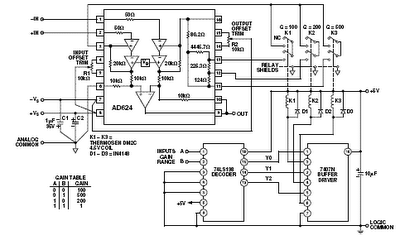
A significant advantage in using the internal gain resistors in a
programmable gain configuration is the minimization of thermocouple
signals which are often present in multiplexed data
acquisition systems.
If the full performance of the AD624 is to be achieved, the user
must be extremely careful in designing and laying out his circuit
to minimize the remaining thermocouple signals.
AD620 useful in many bridge applications
the AD620 is especially suitable for higher resistance pressure
Transducer powered at lower voltages where small size and low
Power become more significant.

Picture shows a 3 kΩ pressure transducer bridge powered from 5 V.
In such a circuit, the bridge consumes only 1.7 mA. Adding the
AD620 and a buffered voltage divider allows the signal to be
conditioned for only 3.8 mA of total supply current. Small size and
low cost make the AD620 especially attractive for voltage output
pressure transducers.
Since it delivers low noise and drift, it will also serve applications
such as diagnostic noninvasive blood pressure measurement.
AD620 datasheet pdf
Selection of the appropriate transducer is therefore the first and most
importance step in obtaining accurate results. The equations should be
asked before a transducer can be select
- What is the physical quantity to be measured ?
For determining the type and range of the measureand.
- Which transducer principle can best be used to measure this quantity?
For determining the input and output characteristic of the
transducer be compatible with the recording or measurement system.
- What accuracy is required for this measurement?
The accuracy requirement of the total system determine the
degree to which individual factor contributing to accuracy must be
considered. Some of these factors are
1. basic electronic and mechanical characteristic of the transducer
- Type and range of measurand
- Sensitivity
- Excitation
- Mechanical and electrical connection
- Mounting provisions
- Corrosion resistance
2. Transducer accuracy , as an independent component
- Nonlinearity effect
- Hysteresis effect
- Frequency response
- Resolution
3. Transducer’s compatibility
- Zero balance provisions
- Sensitivity tolerance
- Impedance matching
- Insulation resistance
Passive Transducers is require external power
- Magnetic circuit transducer
operation = self inductance or mutual inductance of ac-excited coil is
varied by change in the magnetic circuit
- Reluctance pickup
operation = reluctance of the magnetic circuit is varied by change the
position of the iron core of a coil
- Differential Transformer
operation = the differnential voltage of two secondary winding of a
transformer is varied by positioning the magnetic core through an
external applied force
- Eddy current gage
operation = Inductance of a coil is varied by the proximity of an eddy
current plate
- Magnetostriction gage
operation = Magnetic properties are varied by pressure and stress
Passive Transducers is require external power
- variable capacitance pressure gage
operation = distance between two parallel plates is varies by an external
applied force
- capacitor microphone
operation = sound pressure varies the capacitance between a fix plate and
a movable diaphragm
- dielectric gage
operation = variation in capacitance by changes in the dielectric
Passive Transducers is require external power,producing a variation in
Some electrical parameter which can be measured as a voltage or
current variation.
Resistance Transducer Type
- potentionmetric
operation = position of slider by external force varies the resistance in a
potentiometer or bridge circuit
- resistance strain gage
operation = resistance of a wire or semiconductor is change by compression
due to external appile stress
- pirani gage
operation = resistance of a heating element is varied by convection colling of
gas
- thermometer
operation = resistance of pure metal wire with a large positive temperature
coefficient of resistance varies with temperature.
- thermistor
operation = resistance of certain metal oxides with negative temperature
coefficient of resistance varies with temperature.
- hygrometer
operation = resistance of a conductive strip change with moisture content
- photoconductive cell
operation = resistance of the cell as a circuit element varies with incident
We can use a voltage reference turn into a Constant current source We can adjust output current by adjust current setting resistance R
circuit and use pnp-transistors for current-boosting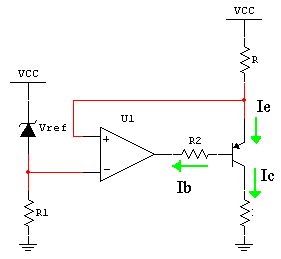
By op amp action ,the voltage across R is away Vref , give
Ie = Vref / R
Ie = Ib + Ic = (Ic/B) + Ic
Ic = [B/(B+1)] *Ie
Io = Ic = [B/(B+1)] * Vref / R about Vref / R
VL = Io*RL
Where maximum voltage of Vl(max) <>
LM340/LM78XX Series
3-Terminal Positive Regulators
The LM140/LM340A/LM340/LM78XXC monolithic
3-terminal positive voltage regulators employ internal
current-limiting, thermal shutdown and safe-area compensation,
making them essentially indestructible. If adequate heat
sinking is provided, they can deliver over 1.0A output current.
They are intended as fixed voltage regulators in a wide
range of applications including local (on-card) regulation for
elimination of noise and distribution problems associated
with single-point regulation. In addition to use as fixed voltage
regulators, these devices can be used with external
components to obtain adjustable output voltages and currents.
Applications circuit of LM340/LM78XX Series
where
Io = Iq + Ireg
Iq = B *Ib
Ib = Ireg – Vbe/R1
Iq = B(Ireg – Vbe/R1)
Io = B*Ireg – B*Vbe/R1 + Ireg
Io = (B+1)*Ireg – B*Vbe/R1
R1*Io = R1 (B+1)*Ireg – B*Vbe
B*Vbe = R1[(B+1)*Ireg - Io]
R1 = B*Vbe / [(B+1)*Ireg - Io]
Example
We want to make regolater circuit 3 A
We choose current of regulater 0.6 A for safety
2N6133 for Q1
Io = 3A
Ireg = 0.6 A
Vbe = 1.4 V
B = 20
R1 = 20*1.4/[(20+1)*0.5 – 3]
R1 = 2.91
We choose R1 = 3 ohm
A half-wave rectifier is a circuit that passes only the positive or only the negative
Portion of a wave ,while blocking out the other portion
Rectifiers are impremented using diodes. The nonzero forward-voltage drop of
A pactical diode may cause intolerable errors in low-level signal
Proceeding of half-wave precision rectifiers circuit we separate are two case
Case 1 Vi > 0 negative input of op amp is higher positive input ,the op amp
Output = 0 ,I1 will flow through R1 and D1 ,hence Vo = 0
Case 2 Vi <>
Output = 1 ,I2 will flow through R2,R1 and D2 ,but the voltage at positive input
Must equal the voltage at negative input ,hence I2 = (0-Vi)/R1 = (Vo-0)/R2
This gives Vo = (-R2/R2)Vi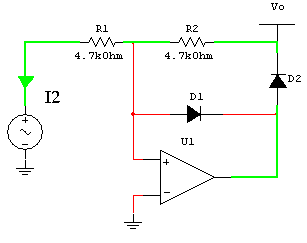
Circuit behavior
Vo = 0 for Vi > 0
Vo = -(R2/R1)Vi for Vi <>
Example waveform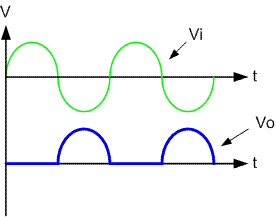
This circuit is application of OP07. adjust variable resistor for null Offset
Voltage output at initrial state

Op07
Op07 represent a breakthrough in operational amplifier performance.
Low offset and long-term stability are achieved by means of a low-noise,
chopperless, bipolar-input-transistor amplifier circuit. For most applications,
external components are not required for offset nulling and
frequency compensation. The true differential input, with a wide input
voltage range and outstanding common-mode rejection, provides
maximum flexibility and performance in high-noise environments and in
noninverting applications. Low bias currents and extremely high input
impedances are maintained over the entire temperature range.
The OP07 is unsurpassed for low-noise, high-accuracy amplification of
very low-level signals.
We can make simple Large Fan-In AND Gate circuit by one Voltage
Comparators from circuit below
Vout = A and B and C and D and ….
This circuit is application of LM139
LM139
Low Power Low Offset Voltage Quad Comparators
The LM139 series consists of four independent precision
voltage comparators with an offset voltage specification as
low as 2 mV max for all four comparators. These were
designed specifically to operate from a single power supply
over a wide range of voltages.
All pins of any unused comparators should be tied to the
negative supply.
The output of the LM139 series is the uncommitted collector
of a grounded-emitter NPN output transistor. Many collectors
can be tied together to provide an output OR’ing function.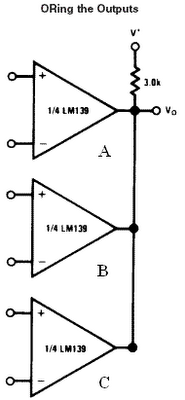
Vo = A or B or C
We can use inverting Schmitt trigger circuit for this application
Inverting Schmitt trigger
the circuit can be view as an inverting –type threshold detector whose
threshold is controlled by the out put since the output has two stable
state, this threshold has two possible values,namly
Vth = R1*Voh/(R1+R2)
Vtl = R1*Vol/(R1+R2)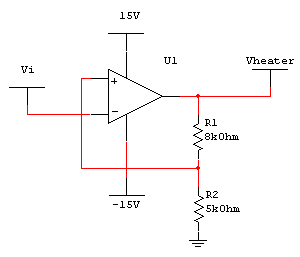
The hysteresis width is defined as
Hw = Vth – Vtl = R1*( Voh – Vol )/( R1 + R2 )
Behaviour of circuit show in below picture.

Sample waveforms ![]()
Thermal stability is the most demanding performance requirement
Of voltage references
Forward drop of a silicon junction decreases about 2mV for every
degree Celsius increase
The idea behind thermal compensated Zener diode is to connect a
forward-biased diode in series with a Zener diode having an equal
but opposing thermal voltage (TC)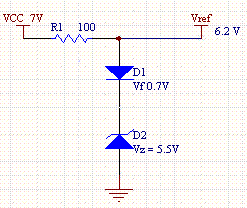
Vref = Vz+Vf = 5.5+0.7 = 6.2 V
Uses Iz = 7.5 mA
R1 = (Vcc-Vref)/Iz = 106.6 ohm
Hall Effect
If an electric current flows through a conductor in a magnetic field,
the magnetic field exerts a transverse force on the moving charge
carriers which tends to push them to one side of the conductor.
This is most evident in a thin flat conductor as illustrated. A buildup
of charge at the sides of the conductors will balance this magnetic
influence, producing a measurable voltage between the two sides of
the conductor. The presence of this measurable transverse voltage
is called the Hall effect
http://230nsc1.phy-astr.gsu.edu/hbase/magnetic/hall.html
The UGN3503LT, UGN3503U, and UGN3503UA Hall-effect
sensors accurately track extremely small changes in magnetic flux
density—changes generally too small to operate Hall-effect switches.
Each Hall-effect integrated circuit includes a Hall sensing element,
linear amplifier, and emitter-follower output stage. Problems associated
with handling tiny analog signals are minimized by having the Hall cell
and amplifier on a single chip.
Application
NOTCH SENSOR
The south pole of a magnet is attached to the back of the package if
the Halleffect IC is to sense the presence of ferrous material.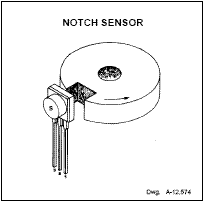
GEAR TOOTH SENSOR
The north pole of a magnet is attached to the back surface if the
integrated circuit is to sense the absence of ferrous matrial.
CURRENT MONITOR
proportional output-voltage levels are dependent on magnetic flux
density at the most sensitive area of the device.
74HC/HCT85 are easy way for 4-bit magnitude comparator circuit
The 74HC/HCT85 are 4-bit magnitude comparators that can be
expanded to almost any length. They perform comparison of
two 4-bit binary, BCD or other monotonic codes and present the
three possible magnitude results at the outputs (QA>B, QA=B and
QA
FUNCTION TABLE

74165 can use for expender input port of microcontroller
74165 are 8-Bit Parallel In/Serial Output Shift Registerswhich shifts data
in the direction of QA toward QH when clocked.Parallel-in access is made
available by eight individual direct datainputs, which are enabled by a low
level at the shift/loadinput. These registers also feature gated clock inputs
and complementary outputs from the eighth bit.
Timing diagram for read data
C code for control 74165 by microcontroller
This circuit used convert signal from Rotary encoder (A,B) to two pulse signal
- Y for CCW direction
- X for CW (clockwise) direction
Two pulse signal is easy for microcontroller programing
The circuit used two D-type flip-flop(74HC74D) for the judgement.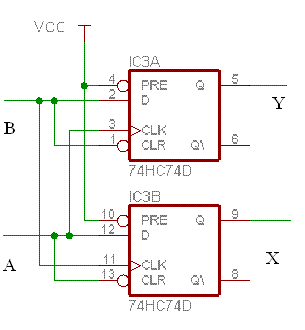
Signal input and signal out put
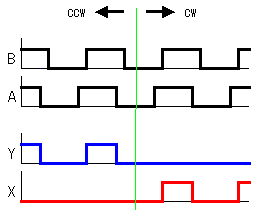
Converter PWM and direction to bridge driver signal circuit
This circuit for convert signal PWM (speed) and signal direction from
microcontroller to signal of motor bridge driver circuit. thay is two pwm
signal A for motor turn right and B for motor turn left

The R-78xx-Series high efficiency switching regulators are ideally
suited to replace 78xx linear regulators and are pin compatible. 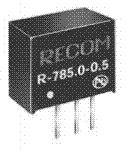
The efficiency of up to 97% means that very little energy is wasted as
heat so there is no need for any heat sinks with their additional space
and mounting costs. Low ripple and noise figures and a short circuit
input current of typically only 7mA round off the specifications of this
versatile converter series.
Features
- Efficiency up to 97%,Non isolated,no need for heatsinks
- Pin-out compatible with LM78XX Linears
- Very low profile( L*W*H=11.5*7.5*10.2 )
- Wide input range.(4.75V ~ 34V)
- Short circuit protection, Thermal shutdown
- Non standard outputs available as specials between 1.5V ~15.5V
- Low ripple and noise
www.recom-international.com
This device is easy way for control 32-Segment display
by three control lines
AY0438 32-Segment CMOS LCD Driver
DESCRIPTION
The AY0438 is a CMOS integrated device that drives a liquid crystal
display, usually under microprocessor control. The part acts as a
smart peripheral that drives up to 32 LCD segments. It needs only
three control lines due to its serial input construction. It latches the
data to be displayed and relieves the microcontroller from the task of
generating the required waveforms.

Each of the PCF8574’s eight I/Os can be independently
used as an input or output.
PCF8574
Remote 8-bit I/O expander for I2C-bus
The PCF8574 is a silicon CMOS circuit. It provides general
purpose remote I/O expansion for most microcontroller
families via the two-line bidirectional bus (I2C).
The device consists of an 8-bit quasi-bidirectional port and
an I2C-bus interface. The PCF8574 has a low current
consumption and includes latched outputs with high
current drive capability for directly driving LEDs. It also
possesses an interrupt line (INT) which can be connected
to the interrupt logic of the microcontroller. By sending an
interrupt signal on this line, the remote I/O can inform the
microcontroller if there is incoming data on its ports without
having to communicate via the I2C-bus. This means that
the PCF8574 can remain a simple slave device.
Address of PCF8574 can set at pin A0,A1,A2
slave addresses.

We can use PISO IC for increase input port of microcontroller
They can expender output port from three port to eight port

74LS165 are 8-Bit Parallel In/Serial Output Shift Registers
which shifts data in the direction of QA toward QH when clocked.
Parallel-in access is made available by eight individual direct data
inputs, which are enabled by a low level at the shift/load
input. These registers also feature gated clock inputs and
complementary outputs from the eighth bit.C code for 74165
We can use SIPO IC for increase output port of microcontroller
They can expender output port from three port to eight port 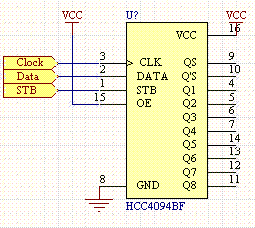
CD74HC4094 are 8-stage serial shift registers having a storage
latch associated with each stage for strobing data from the serial
input to parallel buffered three-state outputs.
Data is shifted on positive clock transitions. The data in each
shift register stage is transferred to the storage register when
the Strobe input is high. Data in the storage register appears
at the outputs whenever the Output-Enable signal is high.
Polyswitch
A PolySwitch (also Polyfuse and Multiswitch) is a polymer form of
positive temperature coefficient resistor (PPTC) which acts as a self
repairing fuse.
"PolySwitch" is a registered trademark of Raychem Corporation. While the
generic term for these devices is sometimes called resettable fuses technically
these are not fuses but actually non-linear thermistors.
A PPTC has a current rating. When the current flowing through the PolySwitch
device, (which acts as a resistor) exceeds the current limit of, (for example)
100 mA, the PPTC device warms up above a threshold temperature and the
electrical resistance of the PPTC device suddenly increases from a few ohms
to a few kiloohms.
We can use series RC circuit and voltage comparator to generate
a time delay. Two resistors R2 and R3 are used as a voltage divider
which applies about two-thirds of the Vcc voltage to the positive
comparator input The delay time after the Vin change form low to
high will be around one time constant

Time constant = R1C1 = 100K * 10uF = 1 seconds.
The delay time can be adjust by adjusting R1 or change C1
..........................................................................................
If you interested in electronic circuit visit the website of
Paul Falstad.
This website includes java applet is an electronic circuit simulator.
Show animated illustrations of how electronic circuits work
http://www.falstad.com/circuit
The LM231/LM331 family of voltage-to-frequency converters
are ideally suited for use in simple low-cost circuits for
analog-to-digital conversion, precision frequency-to-voltage
conversion, long-term integration, linear frequency modulation
or demodulation, and many other functions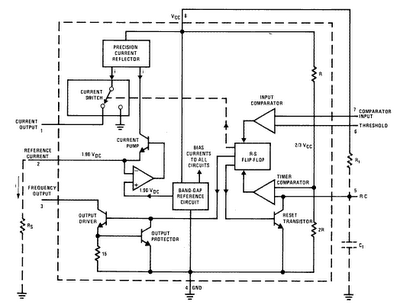
Features
- Guaranteed linearity 0.01% max
- Improved performance in existing voltage-to-frequency
conversion applications
- Split or single supply operation
- Operates on single 5V supply
- Pulse output compatible with all logic forms
- Excellent temperature stability, ±50 ppm/°C max
- Low power dissipation, 15 mW typical at 5V
- Wide dynamic range, 100 dB min at 10 kHz full scale
- Wide range of full scale frequency, 1 Hz to 100 kHz
- Low cost
Frequency-to-Voltage converter circuit can use LM331
(Precision Voltage-to-Frequency Converters) by circuit below
But out put form pin 1 of lm331 is current so we must be careful
Input impredance of circuit that connected with this circuit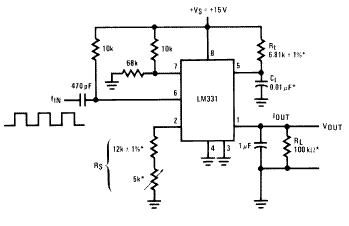
Fin 10kHz full scale
Vout = Fin * 2.09V*(RL/Rs)*(Rt*Ct)
A simple PWM (Pulse width modulation) generator circuit is
LM555 In ASTABLE OPERATION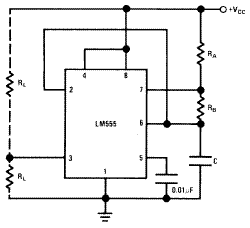
ASTABLE OPERATION
Form circuit it will trigger itself and free run as a multivibrator.
The external capacitor charges through RA + RB and discharges
through RB. Thus the duty cycle may be precisely
set by the ratio of these two resistors.
In this mode of operation, the capacitor charges and discharges
between 1/3 VCC and 2/3 VCC. As in the triggered
mode, the charge and discharge times, and therefore the frequencyare
independent of the supply voltage.

- Top Trace: Output 5V/Div
- Bottom Trace: Capacitor Voltage 1V/Div.
The charge time (output high) is given by:
t1 = 0.693 (RA + RB) C
And the discharge time (output low) by:
t2 = 0.693 (RB) C
Thus the total period is:
T = t1 + t2 = 0.693 (RA +2RB) C
The frequency of oscillation is:
F = 1/T
The duty cycle is:
D = Rb/(Ra+2Rb)
A one-shot timer circuit or interval timer when input trigger pulse
applied. Out put will change to high and remain high until end of
delay time out put will change to low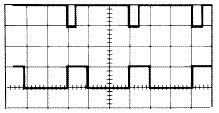
This circuit used LM555 in monostable operation
The external capacitor is initially held discharged
by a transistor inside the timer. Upon application of a negative
trigger pulse of less than 1/3 VCC to pin 2, the flip-flop is
set which both releases the short circuit across the capacitor
and drives the output high.
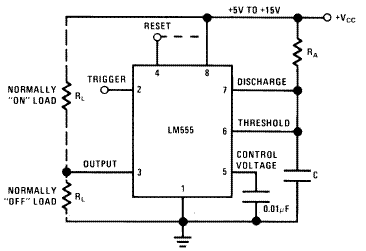
During the timing cycle when the output is high, the further
application of a trigger pulse will not effect the circuit so long
as the trigger input is returned high at least 10μs before the
end of the timing interval. However the circuit can be reset
during this time by the application of a negative pulse to the
reset terminal (pin 4). The output will then remain in the low
state until a trigger pulse is again applied.
Figure below is a nomograph for easy determination of R, C
Values for various time delays of lm555 timer

The ADG3304 is a bidirectional logic level translator that
con-tains four bidirectional channels.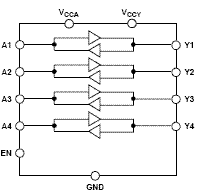
It can be used in multivoltage digital system applications such
as data transfer between a low voltage DSP/controller and a
higher voltage device using SPI and MICROWIRE interfaces.
The voltage applied to VCCA sets the logic levels on the A side
of the device, while VCCY sets the levels on the Y side. For proper
operation, VCCA must always be less than VCCY. The
VCCA-com-patible logic signals applied to the A side of the device
appear as VCCY-compatible levels on the Y side. Similarly,
VCCY-compatible logic levels applied to the Y side of the device
appear as VCCA-compatible logic levels on the A side.
The enable pin (EN) provides three-state operation on both the
A-side and the Y-side pins. When the EN pin is pulled low, the
terminals on both sides of the device are in the high impedance
state. The EN pin is referred to the VCCA supply voltage and
driven high for normal operation.
ADG3304 FEATURES
Bidirectional level translation
Operates from 1.15 V to 5.5 V
Low quiescent current <>
The ADG3123 is an 8-channel, noninverting CMOS to high voltage
level translator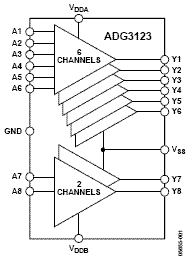
DESCRIPTION
The internal architecture of the device ensures compatibility with logic
circuits running from supply voltages within the 2.3 V to 5.5 V range.
The voltages applied to Pin VDDA, Pin VDDB, and Pin VSS set the
logic levels available at the outputs on the Y side of the device. Pin
VDDA and Pin VDDB set the high output level for Pin Y1 to Pin Y6
and for Pin Y7 to Pin Y8, respectively. The VSS pin sets the low output
level for all channels. The ADG3123 can provide output voltages levels
down to −10 V for a low input level and up to +30 V for a high input
logic level. For proper operation, VDDB must always be greater than or
equal to VDDA and the voltage between the Pin VDDB and Pin VSS
should not exceed 35 V.
FEATURES
- 2.3 V to 5.5 V input voltage range
- Output voltage levels (VDDA and VDDB to VSS ≤ 35 V)
Low output voltage levels: down to −24.4 V
High output voltage levels: up to +35 V
- Rise/fall time: 12 ns/19.5 ns typical
- Propagation delay: 80 ns typical
- Operating frequency: 100 kHz typical
- Ultralow quiescent current: 65 μA typical
- 20-lead, Pb-free, TSSOP package
Analog Signal switching and Multiplexing circuit
CD4066B
CMOS QUAD BILATERAL SWITCH

CD4066B is a quad bilateral anaolog switch intended for the
transmission or multiplexing of analog or digital signals.
It is pin-for-pin compatible with the CD4016B, but exhibits
a much lower on-state resistance. In addition, the on-state
resistance is relatively constant over the full input-signal range.
The CD4066B consists of four bilateral switches, each with
independent controls.
- 15-V Digital or }7.5-V Peak-to-Peak Switching
- 125-Ω Typical On-State Resistance for 15-V Operation
- Switch On-State Resistance Matched to Within 5 Ω Over 15-V
Signal-Input
This device can also be used for general analog signal isolation
applications requiring high accuracy, stability, and linearity
under similarly severe noise conditions.
Analog signal isolation circuit

HCPL-7840
Description
The HCPL-7840 isolation amplifier family was
designed for current sensing in electronic motor drives.
In a typical implementation, motor currents flow through
an external resistor and the resulting analog voltage drop
is sensed by the HCPL-7840.

LCDs connected to the microcontroller in 4 bit data bus mode. LCD will require
a total of 7 data lines
3 control lines plus the 4 lines for the data bus in simple control LCD we will set
RW = 0(write only)
- The EN line is called "Enable."
This control line is used to tell the LCD that you are sending it data.
- The RS line is the "Register Select" line.
RS is low (0), the data is to be treated as a command or special instruction
RS is high (1), the data being sent is text data which sould be displayed on the
screen.
- The RW line is the "Read/Write" control line.
RW is low (0), the information on the data bus is being written to the LCD.
RW is high (1), the program is effectively querying (or reading) the LCD.

The watchdog timer is monitors an I/O line from the
mC system. This line must be toggled once every interval time to
verify correct software execution. Failure to toggle the line indicates
that the mC system is not correctly executing its program
and may be tied up in an endless loop. If this happens, a reset
pulse is generated to initialize the processor.
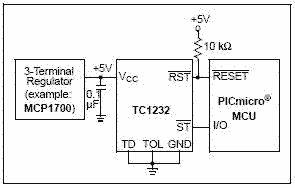
ADM8690–ADM8695
The ADM8690–ADM8695 family of supervisory circuits offers
complete single chip solutions for power supply monitoring and
battery control functions in microprocessor systems. These
functions include mP reset, backup battery switchover, watchdog
timer, CMOS RAM write protection and power failure warning.
The complete family provides a variety of configurations to satisfy
most microprocessor system requirements.
